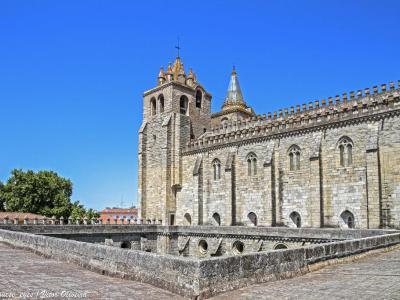
Catedral de Evora (Cathedral of Evora), Evora (must see)
The Cathedral is a roman Catholic church that holds a significant place in the hearts of both locals and visitors alike, gracing the highest point of the city. It serves as the spiritual and administrative seat of the Archdiocese of Évora.
Designated as a UNESCO World Heritage Site in 1988, the Cathedral of Évora has weathered the sands of time and witnessed the ebb and flow of history. Its origins trace back to the 12th century when Évora was definitively recaptured from Arab control by Geraldo Sem Pavor (Gerald the Fearless) in 1166. This victory marked the commencement of the construction of a cathedral dedicated to the Virgin Mary. The initial structure, built between 1186 and 1204, was relatively modest in scale. However, it underwent significant expansion in the early 14th century, embodying the graceful lines of early Gothic architecture.
The cathedral's evolution continued, with each passing century leaving its mark. The Gothic cloisters, dating back to the 14th century, create an aura of tranquility, inviting visitors to stroll through their elegant arches and contemplate the passage of time. A Manueline chapel known as the Esporão, crafted in the early 16th century, speaks to the ornate artistry of the era. One of the most remarkable additions, the grand main chapel in baroque style, was erected during the first half of the 18th century, showcasing the opulence and grandeur of that period.
Designated as a UNESCO World Heritage Site in 1988, the Cathedral of Évora has weathered the sands of time and witnessed the ebb and flow of history. Its origins trace back to the 12th century when Évora was definitively recaptured from Arab control by Geraldo Sem Pavor (Gerald the Fearless) in 1166. This victory marked the commencement of the construction of a cathedral dedicated to the Virgin Mary. The initial structure, built between 1186 and 1204, was relatively modest in scale. However, it underwent significant expansion in the early 14th century, embodying the graceful lines of early Gothic architecture.
The cathedral's evolution continued, with each passing century leaving its mark. The Gothic cloisters, dating back to the 14th century, create an aura of tranquility, inviting visitors to stroll through their elegant arches and contemplate the passage of time. A Manueline chapel known as the Esporão, crafted in the early 16th century, speaks to the ornate artistry of the era. One of the most remarkable additions, the grand main chapel in baroque style, was erected during the first half of the 18th century, showcasing the opulence and grandeur of that period.
Want to visit this sight? Check out these Self-Guided Walking Tours in Evora. Alternatively, you can download the mobile app "GPSmyCity: Walks in 1K+ Cities" from Apple App Store or Google Play Store. The app turns your mobile device to a personal tour guide and it works offline, so no data plan is needed when traveling abroad.
Catedral de Evora (Cathedral of Evora) on Map






Sight Name: Catedral de Evora (Cathedral of Evora)
Sight Location: Evora, Portugal (See walking tours in Evora)
Sight Type: Religious
Guide(s) Containing This Sight:
Sight Location: Evora, Portugal (See walking tours in Evora)
Sight Type: Religious
Guide(s) Containing This Sight:
Walking Tours in Evora, Portugal
Create Your Own Walk in Evora
Creating your own self-guided walk in Evora is easy and fun. Choose the city attractions that you want to see and a walk route map will be created just for you. You can even set your hotel as the start point of the walk.
Evora Introduction Walking Tour
Nestling in the sun-drenched Alentejo region of Portugal, Évora is a timeless gem in the heart of the country and one of its oldest and most enchanting cities.
The city's history spans over 5,000 years. The name Évora originates from the Celtic word "ebura," which means "of the yew trees."
The Romans conquered the place in 57 BC, shaping it into a vital town at... view more
Tour Duration: 2 Hour(s)
Travel Distance: 3.3 Km or 2.1 Miles
The city's history spans over 5,000 years. The name Évora originates from the Celtic word "ebura," which means "of the yew trees."
The Romans conquered the place in 57 BC, shaping it into a vital town at... view more
Tour Duration: 2 Hour(s)
Travel Distance: 3.3 Km or 2.1 Miles

